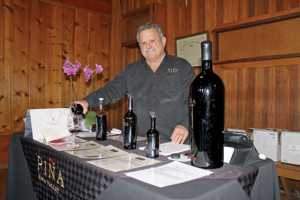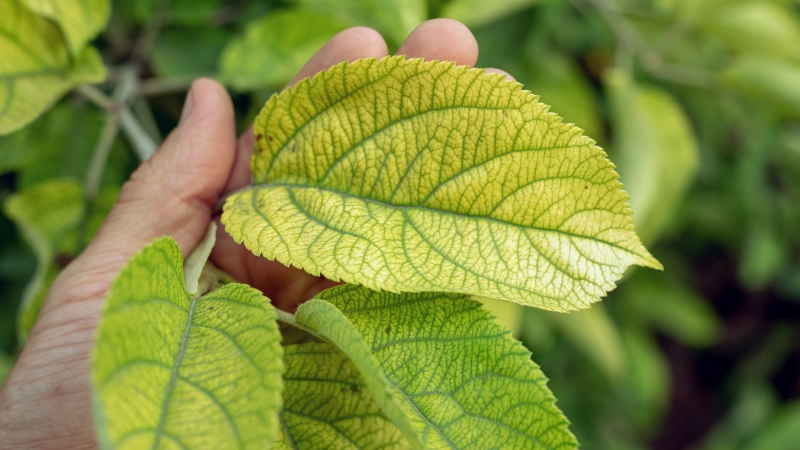Napa Winegrower Group Takes Active Environmental Role
“It takes Rutherford dust to grow great Cabernet.” – Andre Tchelistcheff

“We claim we’re the best environmental group in Napa County,” says Davie Piña of the Rutherford Dust Restoration Team. Here his brother John pours Piña Napa Valley Cabernet Sauvignon at the Rutherford Dust Society’s annual Passport Weekend, where visitors travel to participating wineries. (Photo credit: David Eddy)
Andre Tchelistcheff’s words above live on today in more ways than one. Tchelistcheff, who served as winemaker at Beaulieu Vineyard for decades prior to his death in 1994, had a hand in the most obvious way, the many awards won by wines from the Napa Valley viticultural area.
To take advantage of Rutherford’s reputation, the Rutherford Dust Society was formed in 1994, says the society’s president, Regina Weinstein. The organization was started by Andy Beckstoffer, one of the biggest growers in Napa Valley, who thought it would be a great way to draw attention from both the wine trade and the media. But today it means even more.
In 2002, the Rutherford Dust Society Board of Directors voted unanimously to empower a subcommittee, the Rutherford Dust (Napa River) Restoration Team (RDRT, or “our dirt”), to initiate a plan to manage and restore the 4.5-mile Rutherford Reach of Napa River. This committee is chaired by Rutherford Dust Society board member Davie Piña, owner of Piña Vineyard Management, and includes 27 riverside property owners.
Since that date, RDRT has successfully pioneered an innovative partnership with Napa County. Piña says the movement got under way with $50,000 in seed money from the society for a conceptual design. Since then they have received grants from the Napa County Flood Control and Water Conservation District with money raised through a half-cent sales tax.
Almost Finished
Project construction finally began in 2009, starting at the upstream boundary of the project area at the Zinfandel Lane Bridge, and Piña says it should be finished in 2014. Restoring a river doesn’t sound like a big job, but Piña says that over the past century many of the channels that led to the river had been filled in to maximize vineyard acreage.
“The property owners gave up a lot,” he says of the extremely valuable real estate. “The vineyards were set back an average of 75 feet.”
After moving the sides of the river back, the banks were planted with vegetation so they could be stabilized. Because of that, there’s a lot less sediment going into the river, which can be harmful for fish. There are also practical advantages for the growers, notes Piña. “Vineyard owners get rid of non-native habitat for sharpshooters, which can vector Pierce’s disease,” he says. “And bobcats and all sorts of animals are repopulating the river, so it’s been good for everybody.”
Not that it was easy, says Piña. Besides giving up that valuable land, the property owners have had to slog through a lot of bureaucracy, working with a slew of government agencies, such as Fish and Game and EPA. But while some so-called environmental organizations perceive problems and react by protesting, he notes that RDRT is proactive. “We claim we’re the best environmental group in Napa County.”
About Rutherford
The Rutherford Viticultural Area is approximately 6 square miles, beginning just south of Cakebread Cellars and Beaulieu Vineyard #2 along Highway 29. It ends at Zinfandel Lane, 3.3 miles to the north, and stretches across the valley 2 miles at its widest point from Mt. St. John on the West to the Vaca Mountain Range on the East.
Soil: Soils from three alluvial fans are primarily gravelly, sandy, and loamy. The fans are formed from shattered, well-bedded sandstone, and their deposits are high in gravels. Deep and well-drained, the fans have pockets that allow runoff to easily flow to the streams and Napa River. Rutherford soils are dominated by the Franciscan marine sedimentary materials with some volcanic deposits (primarily Bale, Pleasanton, and Yolo loams).
Sun Exposure: One of the more unusual aspects about Rutherford is that it has a higher radiant value than other parts of Napa Valley. Because the area is located at Napa Valley’s widest point, it spends more time in the sun. University of California-Davis categorizes Rutherford as a Region II, with more than 3,000 degree days during the growing season.
Climate: Warm summer days ripen Rutherford grapes, giving way to cool evenings. An average summer day may drop 12˚F immediately after sunset. This fluctuation allows the fruit to ripen at a steady pace; temperatures north and south of Rutherford can vary as much as 10 degrees. Rutherford has an average rainfall of 26 to 36 inches per year. Although typically mild, spring can bring freezing temperatures at night during March and April.
Topography: Although bordered on the west and east by two mountain ranges, the Rutherford Viticultural Area does not extend above 500 feet in elevation. Regardless, the elevation is quite pronounced. Vineyards creep up the nearby hillsides from the Napa River in the center of the appellation, which lies just 172 feet above sea level.
The Other Sauvignon
While Rutherford is justly known for producing some of the world’s finest Cabernet Sauvignon, the president of the Rutherford Dust Society says it should be also be known for producing great Sauvignon Blanc.
Regina Weinstein, a member of the Honig family and marketing director at Honig Vineyard and Winery, isn’t precisely sure why Sauvignon Blanc hasn’t achieved greater popularity. Part of it’s due to the fact it’s seen as something of a poor stepsister to Chardonnay, which is not only a public perception but extends to some members of the winegrowing community. “It isn’t held in as high a regard, maybe because it’s easy to plant and harvest,” she says. “It’s very hardy — much easier to grow than Chardonnay.”
Honig started farming in 1964, and when it began making wine in 1980, Sauvignon Blanc wasn’t popular. Weinstein says the only winery that was having a lot of success with it was Mondavi, who called their version “Fumé Blanc.”
However, Honig and other Rutherford wineries eventually started winning the palates of wine drinkers, and she says the variety began taking off after the turn of the millennium. It got an added boost in 2007, when Honig and a few other wineries formed an arm of the Rutherford Dust Society that focuses on consumers called Rutherford Appellation Wineries.
“Rutherford is an awesome area for growing Cabernet Sauvignon and Sauvignon Blanc,” says Weinstein. “We make 50,000 to 60,000 cases (of the latter) annually, and we sell out every year.”









